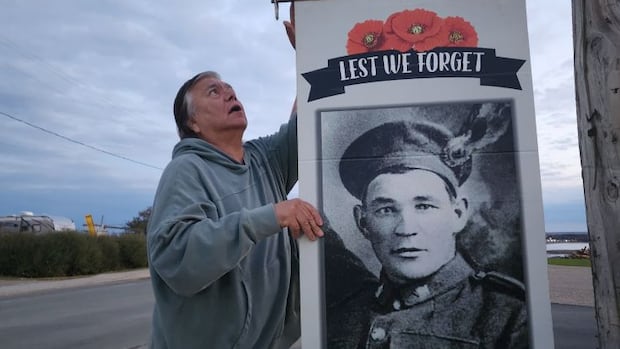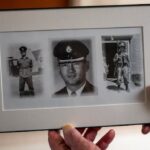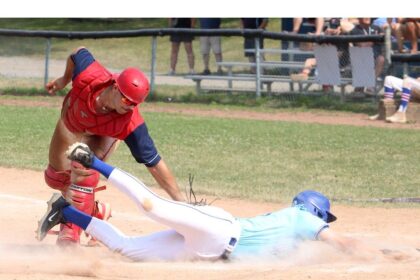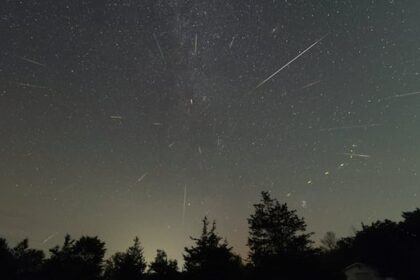IndigenousEel River Bar First Nation, a small Mi’kmaw community in northern New Brunswick honours its veterans by hanging banners each year.Generations find ways to show their respect to their veteransSis’moqon · CBC News · Posted: Nov 11, 2025 3:00 AM EST | Last Updated: 2 hours agoListen to this articleEstimated 4 minutesThe audio version of this article is generated by text-to-speech, a technology based on artificial intelligence.Jake Caplin hangs a banner in Eel River Bar for his great-grandfather, Joseph Simonson, who served in both World Wars. (Submitted by Jake Caplin)Eel River Bar, a Mi’kmaw community in northern New Brunswick, takes pride in their veterans, with multiple generations finding different ways to honour their memories. Arianna Gauvin Sanders, 17, has taken an interest in her community’s military history, including her great-grandparents, Michael and Margaret (Pictou) Labillois, who both served in the Second World War. “I wanted to learn more about the significance of everything they’ve done,” she said.”It made me feel more connected to that part of my family.”Through a high school credit program with North Shore Legacy last year, she researched Indigenous veterans and their impact in the First and Second World Wars.She said she was struck by the lack of documentation that existed on most Indigenous soldiers from that time, compared to their non-Indigenous counterparts.In 2024, she travelled to Normandy to retrace the steps of New Brunswick soldiers who landed on Juno Beach, where she sang the Mi’kmaw honour song at the ceremony and laid tobacco ties on graves of Indigenous soldiers.Arianna Gauvin Sanders speaking at a ceremony in 2024 at Normandy, she and others from her community led a smudging ceremony and shared the Mi’kmaw Honour Song (Submitted by Arianna Gauvin Sanders)According to Canada, at least 3,000 First Nations members enlisted during the Second World War and an unknown number of Inuit and Métis soldiers, though the numbers are thought to be higher. “Even though they weren’t considered Canadian citizens, they still fought,” she said. Now a Grade 12 student, she was master of ceremonies at her school’s Remembrance Day event on Friday, for the second year. Each year, she looks for her great-grandparents’ banners among the 33 hung in Eel River Bar to honour Mi’kmaw veterans in the community. “I feel a sense of pride,” she said.“I am just happy seeing them get their recognition, too.”Hometown hero bannersFormer chief Jake Caplin said he personally hangs up a banner of his great-grandfather Joseph Simonson, every year, who served in both the First and Second World Wars.”I always feel that connection with him because he’s my great-grandfather and I’m very proud of him,” said Caplin.Caplin organized the banners after driving through Presque Isle, Maine, a number of years ago and seeing similar banners, sparking inspiration to bring that initiative home.With 885 registered members, 350 on-reserve, Caplin reflected on the number of members who enlisted. He said many also enlisted in the U.S. military. Eel River Bar hangs banners of Veterans from the community each year to commemorate Remembrance Day. (Submitted by Jake Caplin)“They wanted to do what was right and they wanted to fight for their country and I think that’s what played a big part in [those numbers],” said Caplin.“They thought Canada was doing everything right for them at the time, and we all know now that Canada didn’t exactly treat them that way.”Colleen Gauvin, Arianna’s grandmother, shares the same pride her granddaughter feels looking at her parents’ banners.“I look for them,” said Gauvin.Around the time the Second World War broke out, her mother Margaret (Pictou) Labillois met a recruiter on the train on the way to nursing school in nearby Campbellton, N.B.Colleen Gauvin, grandmother of Arianna Gauvin Sanders and daughter of Michael and Margaret (Pictou) Labillois. (Submitted by Barbie Gauvin)“They told my mother that if she joined the Air Force, they would pay her and she could send money home to her mother,” she said. Labillois signed up hopeful at the prospect of helping her mother financially and served in the Royal Canadian Air Force Women’s Division as a photo reconnaissance technician along the Alaskan Highway during the Second World War.She later became the first female chief of Eel River Bar, where she left a legacy of her passion for Mi’kmaw language and cultural revitalization. She was honoured with the Order of Canada in 1996, and the Order of New Brunswick in 2005.Margaret (Pictou) Labillois portrait from her time in the Royal Canadian Air Force Women’s Division. (Submitted by Barbie Gauvin)Gauvin’s father, Michael Labillois, was a residential school survivor and served as private first class in the Service Corps Transport in Canada, England, France, Germany, and Holland. She recalls stories of her father picking up body parts at night.“He went from one hell… you know, residential school, to another hell,” she said.“But he came home and I was so proud.”Michael Labillois and Margaret (Pictou) Labillois, on the right, at a Remembrance Day ceremony. Both from Eel River Bar First Nation and both served during the Second World War. (Submitted by Barbie Gauvin)Gauvin reflects on her community and the legacy many members left behind in fighting for both the US and Canada at the time.“That’s them, you know. That’s who we are. We’re very proud people.”ABOUT THE AUTHORSis’moqon is a Mi’kmaw woman from Ugpi’ganjig First Nation. She is a reporter with CBC Indigenous. She currently resides in Kjipuktuk, also known as Halifax. You can email her at sis.moqon@cbc.ca with story ideas.
Tuesday, 11 Nov 2025
Canada – The Illusion
Search
Have an existing account?
Sign In
© 2022 Foxiz News Network. Ruby Design Company. All Rights Reserved.
You May also Like
- More News:
- history
- Standing Bear Network
- John Gonzalez
- ᐊᔭᐦᑊ ayahp — It happened
- Creation
- Beneath the Water
- Olympic gold medal
- Jim Thorpe
- type O blood
- the bringer of life
- Raven
- Wás’agi
- NoiseCat
- 'Sugarcane'
- The rivers still sing
- ᑲᓂᐸᐏᐟ ᒪᐢᑿ
- ᐅᑳᐤ okâw — We remember
- ᐊᓂᓈᐯᐃᐧᐣ aninâpêwin — Truth
- This is what it means to be human.
- Nokoma












